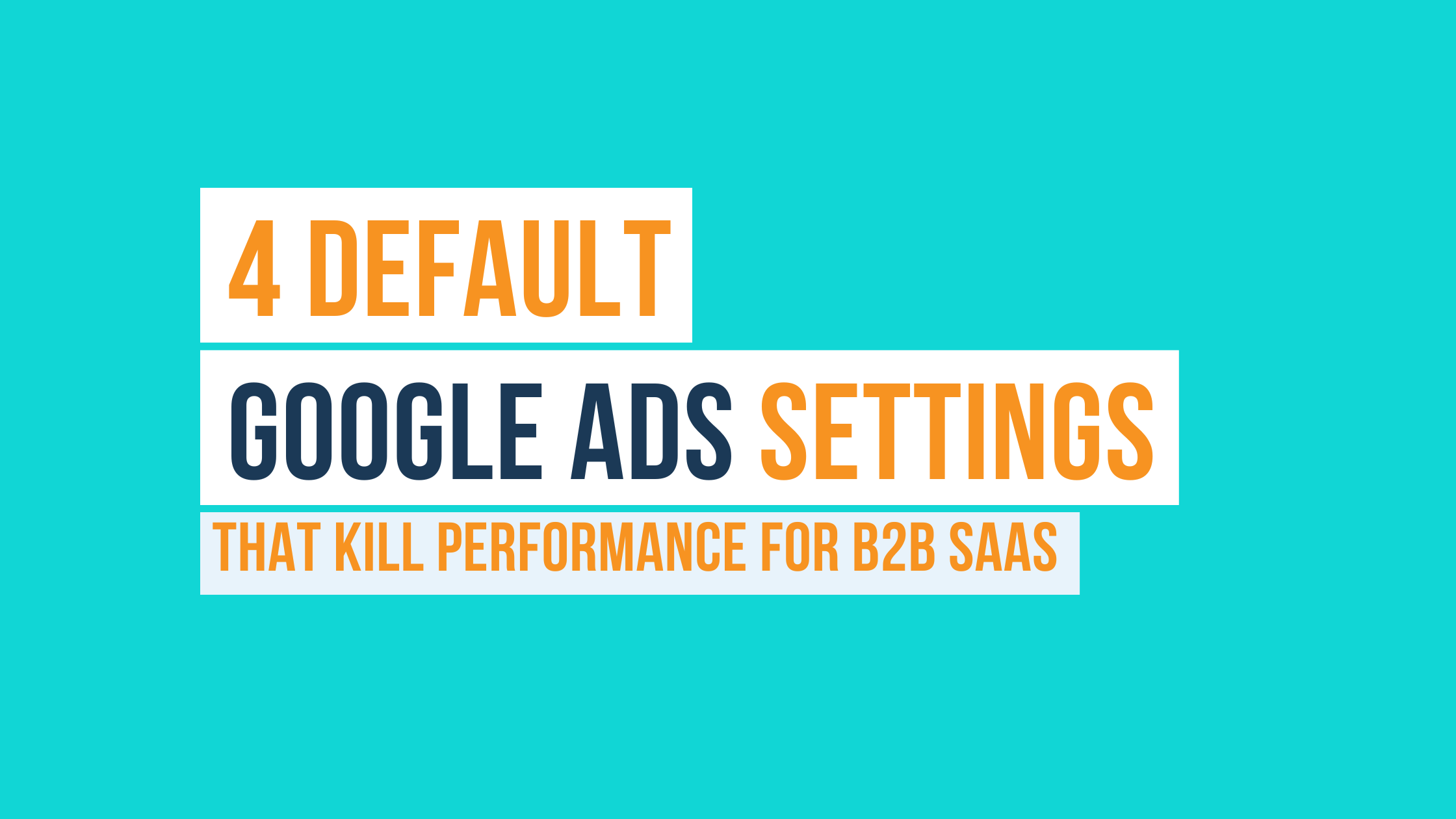
In the world of digital marketing, Google Ads is one of the most powerful tools available, particularly for SaaS companies looking to grow their customer base and increase revenue. However, the effectiveness of Google Ads for SaaS is not guaranteed. Many marketers make the mistake of relying on default settings, which can severely hamper performance and waste valuable budget. In this comprehensive guide, we’ll explore four key default settings in Google Ads for SaaS that can kill your campaign performance and offer actionable strategies to optimize them.
Understanding the Importance of Customization in Google Ads for SaaS
Before diving into the specific settings, it’s essential to understand why customization is so crucial in Google Ads for SaaS. SaaS companies operate in a highly competitive environment where precise targeting and budget efficiency are vital for success. Default settings in Google Ads are designed to be broad and generic, which means they might work for some businesses but are unlikely to be optimized for the specific needs of a SaaS company. By customizing your Google Ads for SaaS, you can align your campaigns more closely with your business goals, improve ROI, and outpace the competition.
1. Auto-Apply Recommendations
What Are Auto-Apply Recommendations?
Auto-apply recommendations are automated suggestions made by Google to optimize your campaigns. These suggestions can include adding new keywords, adjusting bids, or enabling additional features. On the surface, this might seem like a helpful tool, especially for marketers who are pressed for time. However, the reality is that these auto-apply recommendations can lead to significant inefficiencies and budget wastage.
Why Auto-Apply Recommendations Hurt Google Ads for SaaS
Google’s primary objective is to maximize your ad spend, which doesn’t always align with your goal of getting the best possible return on investment.
When you enable auto-apply recommendations in Google Ads for SaaS, Google can make changes to your campaigns without your explicit approval.
This often results in the inclusion of irrelevant keywords that don’t align with your SaaS offering, poorly timed bid adjustments that don’t consider your peak conversion times, and the activation of features that may not be relevant to your target audience.
For example, Google might recommend adding broad-match keywords to capture a larger audience.
While this might increase the number of clicks, it often leads to a lower conversion rate as these broad keywords attract less qualified leads.
For SaaS companies, where the sales cycle is longer and the customer acquisition cost is higher, this can be particularly damaging.
How to Take Control of Auto-Apply Recommendations
To ensure that your Google Ads for SaaS campaigns are optimized for performance and not just for spend, it’s crucial to disable auto-apply recommendations.
Here’s how you can do it:
Navigate to the Recommendations Tab: In your Google Ads dashboard, head to the Recommendations tab. This is where Google provides its automated suggestions.
Access Auto-Apply Settings: In the top right corner, you’ll find the Auto-apply button. Click on it to access the settings.
Customize Your Preferences: Expand the dropdown’s under “Maintain your ads” and “Grow your business.”
Here, you can review the specific recommendations that Google might automatically apply. Deselect all the options that don’t align with your strategic goals.
Manual Review: Make it a habit to manually review the recommendations Google provides. While some may be useful, it’s essential to apply them selectively based on your campaign’s specific needs and objectives.
By taking control of this setting, you ensure that every change made to your Google Ads for SaaS campaigns is intentional and aligned with your business goals.
2. Only Bid for New Customers
The Importance of Targeting New Customers in SaaS
For most SaaS companies, the primary goal of digital advertising is to acquire new customers.
However, one of the most overlooked settings in Google Ads for SaaS is the option to bid exclusively for new customers.
By default, Google Ads for SaaS campaigns might bid equally for both new and existing customers, which can dilute the effectiveness of your budget.
Why the Default Setting Is Problematic
When you bid equally for new and existing customers, your ads may be shown to individuals who have already converted or are in the later stages of the customer journey.
While retaining and upselling to existing customers is essential, your Google Ads for SaaS campaigns should primarily focus on new customer acquisition unless you have a specific strategy for targeting existing customers.
For example, if your SaaS product is designed to solve a specific problem that new customers are facing, showing ads to existing customers who have already solved that problem with your product doesn’t make much sense.
This approach not only wastes budget but also reduces the overall efficiency of your campaigns.
How to Optimize Bidding for New Customers
To ensure that your Google Ads for SaaS campaigns are optimized for growth, follow these steps:
Access Campaign Settings: Go to the settings of the campaign you wish to optimize.
Customer Acquisition Dropdown: Locate the “Customer acquisition” dropdown menu within your campaign settings.
Optimize for New Customers: Select the checkbox that says “Optimize campaign for acquiring new customers.” This setting tells Google to focus your bids on individuals who have not yet converted, ensuring your budget is directed toward acquiring new customers.
Monitor and Adjust: Regularly monitor the performance of this setting. If you notice that your cost-per-acquisition (CPA) is increasing, you may need to further refine your targeting or adjust your bids.
By enabling this setting, your Google Ads for SaaS campaigns will be more focused on driving new customer acquisition, which is crucial for long-term growth.
3. Mobile Bid Adjustments
The Role of Device Targeting in SaaS
Device targeting is another critical aspect of Google Ads for SaaS.
While mobile traffic is essential in many industries, B2B SaaS companies often see better performance from desktop devices.
This is because B2B buyers typically engage in detailed research before making purchasing decisions, and desktops provide a more conducive environment for this type of activity.
Why Mobile Traffic Can Be Less Effective
Mobile clicks are often cheaper and more numerous, but they don’t always translate into high-quality leads for SaaS companies.
B2B buyers, particularly those looking for SaaS solutions, are more likely to convert on desktop devices, where they can easily access detailed product information, compare features, and engage with demo or trial offerings.
In Google Ads for SaaS, equal bidding across devices can lead to an overemphasis on mobile traffic, resulting in lower conversion rates and a higher cost per lead.
By adjusting your bids based on device performance, you can ensure that your budget is spent on the devices most likely to drive conversions.
How to Adjust Mobile Bids in Google Ads for SaaS
To optimize your device targeting in Google Ads for SaaS, follow these steps:
Access Insights & Reports: Go to the Insights & reports section of your Google Ads dashboard.
Analyze Device Performance: Navigate to When & where ads showed > Devices. Here, you can view the performance data for different devices, including mobile, desktop, and tablet.
Identify Trends: Look for trends in your conversion data. If you notice that mobile traffic has a lower conversion rate or a higher cost-per-acquisition, it may be time to adjust your bids.
Apply Bid Adjustments: Apply at least a -50% bid adjustment for mobile phones and tablets. In some cases, particularly if mobile traffic is performing poorly, you may want to exclude mobile devices from your campaigns entirely.
Continuous Optimization: Device performance can change over time, so it’s important to regularly review your bid adjustments and make changes as needed to ensure optimal performance.
By prioritizing high-quality leads from desktop devices, you can improve the overall effectiveness of your Google Ads for SaaS campaigns.
4. Age Audiences 18-24
The Importance of Demographic Targeting in SaaS
In Google Ads for SaaS, demographic targeting is a powerful tool for ensuring that your ads reach the most relevant audience. However, one common mistake is including the 18-24 age group in your targeting by default.
While this younger demographic can be valuable in certain industries, it’s often less effective for B2B SaaS companies.
Why the 18-24 Age Group Might Not Be Ideal
Research shows that most B2B SaaS buyers and decision-makers are typically over 25 years old. This is because B2B purchasing decisions are usually made by individuals with significant experience and authority within their organizations—characteristics that are less common in the 18-24 age group.
When you include this younger demographic in your Google Ads for SaaS campaigns, you risk allocating budget to an audience that is less likely to convert into paying customers. This can lead to higher acquisition costs and lower overall campaign efficiency.
How to Refine Age Targeting in Google Ads for SaaS
To ensure your Google Ads for SaaS campaigns are reaching the most relevant audience, follow these steps:
Access Campaign Settings: Navigate to the settings of the campaign you wish to optimize.
Demographics Tab: Go to the Demographics tab within your campaign settings.
Exclude Younger Audiences: Exclude the 18-24 age group from your audience targeting. You can do this by unchecking the box next to this age group.
Test and Measure: If you’re unsure about excluding this age group, consider running a split test. Create two identical campaigns, with one targeting all age groups and the other excluding the 18-24 age group. Compare the performance to determine if the exclusion improves your conversion rates and reduces your CPA.
By refining your age targeting, you ensure that your Google Ads for SaaS campaigns are focused on the demographics most likely to convert, leading to more efficient use of your ad budget.
Conclusion: Taking Control of Google Ads for SaaS
Managing Google Ads for SaaS is a complex task that requires ongoing attention and optimization. Default settings, while convenient, are rarely optimized for the unique needs of SaaS companies. By taking the time to adjust settings like auto-apply recommendations, bidding for new customers, mobile bid adjustments, and age targeting, you can significantly improve the performance of your Google Ads for SaaS campaigns.
These changes may require an initial investment of time and effort, but the long-term benefits—such as improved ROI, lower customer acquisition costs, and higher conversion rates—are well worth it. Remember, the key to successful Google Ads for SaaS is continuous optimization. Regularly review your campaign performance, make data-driven adjustments, and stay ahead of the competition in the ever-changing SaaS landscape.
By mastering these settings, you can ensure that your Google Ads for SaaS campaigns not only avoid common pitfalls but also thrive in a highly competitive market.

